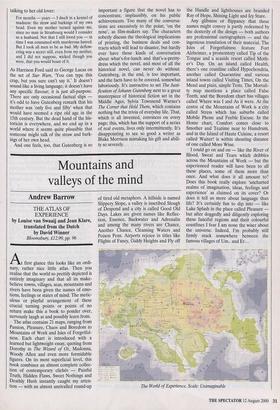Mountains and valleys of the mind
Andrew Barrow
THE ATLAS OF EXPERIENCE by Louise van Swaaij and Jean Klare, translated from the Dutch by David Winner Bloomsbury, 412.99, pp. 96 Afirst glance this looks like an ordi- nary, rather nice little atlas. Then you realise that the world so prettily depicted is entirely imaginary and that all its make- believe towns, villages, seas, mountains and rivers have been given the names of emo- tions, feelings or states of mind. The metic- ulous or playful arrangement of these crucial turning points or points of no return make this a book to ponder over, nervously laugh at and possibly learn from.
The atlas contains 21 maps, ranging from Passion, Pleasure, Chaos and Boredom to Mountains of Work and Isles of Forgetful- ness. Each chart is introduced with a learned but lightweight essay, quoting from Dorothy in The Wizard of Oz, Madonna, Woody Allen and even more formidable figures. On its most superficial level, this book combines an almost complete collec- tion of contemporary clichés — Painful Truth, Hidden Flaws, Sweet Nothings and Deathly Hush instantly caught my atten- tion — with an almost unrivalled round-up of tired old metaphors. A. hillside is named Slippery Slope, a valley is inscribed Slough of Despond and a city is called Good Old Days. Lakes are given names like Reflec- tion, Essence, Backwater and Adrenalin and among the many rivers are Chance, Another Chance, Cleansing Waters and Poison Pens. Airports rejoice in titles like Flights of Fancy, Giddy Heights and Fly off the Handle and lighthouses are branded Ray of Hope, Shining Light and Icy Stare.
Any glibness or flippancy that these names might convey is partly redeemed by the dexterity of the design — both authors are professional cartographers — and the ingenious translation of their material. The Isles of Forgetfulness feature Fort Alzheimer, a promontory called Tip of the Tongue and a seaside resort called Moth- er's Day. On an island called Health, there's one coastline called Hypochondria, another called Quarantine and various inland towns called Visiting Times, On the Mend and plain, simple Tests. The Mortali- ty map mentions a place called False Teeth, and the Boredom chart has villages called Where was I and As it were. At the centre of the Mountains of Work is a city called Stress which has suburbs called Mobile Phone and Feeble Excuse. In the Home chart, Comfort comes close to Smother and Teatime near to Humdrum, and in the Island of Haute Cuisine, a resort called Waiter! is within shouting distance of one called More Wine.
I could go on and on — like the River of Blood, Sweat and Tears which dribbles across the Mountains of Work — but the experienced reader will have been to all these places, some of them more than once. And what does it all amount to? Does this book really explore 'uncharted realms of imagination, ideas, feelings and experience' as claimed on its cover? Or does it tell us more about language than life? It's certainly fun to dip into — like Lake Splash in the place called Pleasure — but after doggedly and diligently exploring these fanciful regions and their colourful coastlines I fear I am none the wiser about the universe. Indeed, I'm probably still firmly stuck somewhere between the famous villages of Urn„ and Er...
The World of Experience. Scale: Unimaginable


























































 Previous page
Previous page